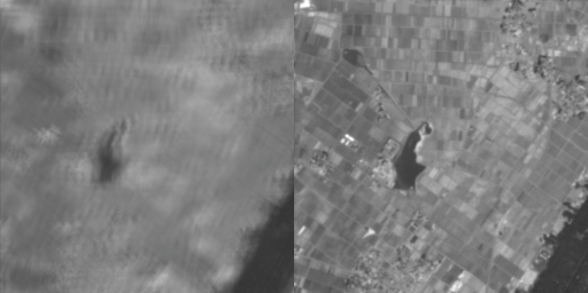Optical Correlator Testbed for high-resolution imaging from geostationary orbit
| Programme: | TRP Workplan | Achieved TRL: | 4 |
| Reference: | T116-312MM | Closure: | 2016 |
| Contractor(s): | TU Dresden (DE), Astro und Feinwerktechnik Adlershof (DE), CSEM (CH) | ||
High-resolution GEO observations require ultra-high pointing stability to avoid motion blur and Modulation Transfer Function (MTF) degradation. Traditional solutions based on the satellite attitude measurements with the star sensors can be insufficient due the accuracy/bandwidth limitations and non-rigidity of the satellite structure.
Objectives
The project provides an analysis of an alternative solution for pointing instability compensation based on the precise real time measuring of pointing vector during integration time directly in the focal plane (visual feedback) with on-board optical correlator: for each scene a sequence of short-exposed sub images is taken, then sub-images are mutually registered and stacked; thus the relative pointing error is compensated.
Achievements
- Concept of high resolution GEO imaging system with optical correlator has been developed.
- Expected imaging performances have been estimated by simulation experiments with the optical correlator test bed on the basis of the optical correlator hardware model.
- Vacuum compatibility of key optoelectronic components and vibration tolerance of the optical correlator model have been proven; future project phases for optical correlator verification on the Low Earth Orbit have been defined.
- A concept of the colour-coded images registration with software-based correlator for the application on a miniaturised hyperspectral instrument has been proposed. Feasibility of the concept has been proven and image registration accuracy has been estimated as a result of two successive CCNs (registration error as low as 0.025 … 0.05 pixels one sigma can be practically achieved).

Benefits
Tested approach makes possible to relax significantly the requirements for the satellite attitude stability. Further improvement can be achieved by the active line of sight stabilisation during exposure with steerable (tilting or deformable) mirror, focal plane image detector and the optical correlator in the control loop.
Future work
- Optimisation of the correlation-based algorithms for co-registration of the colour-coded images and development of the real time breadboard concept considering future application on a miniaturised hyperspectral instrument
- Analysis of the active line of sight stabilization solution based on the steerable mirror and optical correlator in the visual feedback loop
- LEO validation of the imaging system model with the optical correlator prototype

